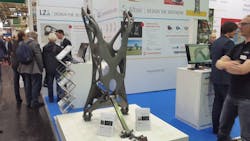Thanks to continued technological advances, 3D printing remains on a roll. The previous trend centered on 3D printers in the Maker space using the fused filament fabrication (FFF) technique. Moving into the spotlight, however, is additive manufacturing—an area that actually comprises seven different processes for 3D printing. Here are some recent highlights:
First, Oak Ridge National Laboratory was pushing the envelope at the 2017 CONEXPO-CON by printing the boom and cab of a full-sized excavator. For more information, check out this article and video.
Next, researchers from multiple universities and research centers published a peer-reviewed journal in 3D Printing and Additive Manufacturing about a new support material for metal printing. The new dissolvable metal support enables 3D printing of complex structures. This is important, as there is a lot of post-processing in 3D printing. In fact, some parts might take more time to post-process than they do to print. This new dissolvable metal support could help automate the finishing process and make 3D printing more attractive to customers.
Researchers fabricated a dissolvable carbon steel to support larger stainless steel structures. Later, a electrochemical process dissolves the carbon steel by bubbling oxygen in a nitric acid. This new technology will help progress 3D printing. Finding a higher ROI can be difficult for 3D printing. Currently, small parts with complex geometries and short production runs are the low-hanging fruit. However, researchers are pushing for large metal printing.
Large metal parts are normally reserved for casting process. Could 3D printing encroach on casting parts?
The third update comes from Hazleton Casting Company (HCC) in Eastern Pennsylvania. HCC has started offering fast turnaround casting by using 3D printing to print molds for casting. This is done in a binder jetting process. This is where sand is built up in layers, and a binder agent is applied in the shape of the mold—not the part. The mold will take about an hour to solidify, is cleared of any remaining sand, and is then ready to pour.
The Hazleton Company used a standard ABB IRB 260 industrial robot that offered a build space of 1 × 2 × 3 ft. named RAM 123 from Viridis3D. This system is able to print at about 1.5 to 2.5 vertical in. per hour with accuracies at ±0.010 in.
Adding to this trend was Altair, at this year’s Hannover Messe. The company was showing off a study on lightweighting a large metal piece of agricultural equipment. Touting a gantry system with about a 13 × 6.5 × 3.3 ft. build space, the part reduced the original weight of the part by about 103 lb. While the representative mentioned that manufacturing this way was impractical due to cost, it was still a good case study on the possibilities of this technology.
Is it impractical, however? Hazleton may beg to differ, as the new RAM 123 from Viridis3D is bringing in new business to the company. It’s working so well, in fact, that Hazleton has even commented on how this could be scaled up with larger robots.
This is one of the new ways 3D printing is working its way into more traditional processes. As knowledge and comfort with 3D printing grows, 3D printing will continue to find new ways to disrupt what we thought we knew.



